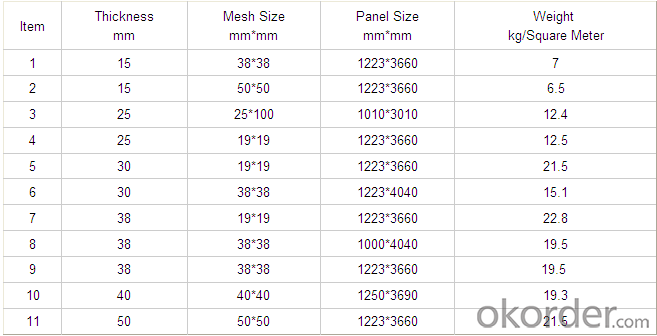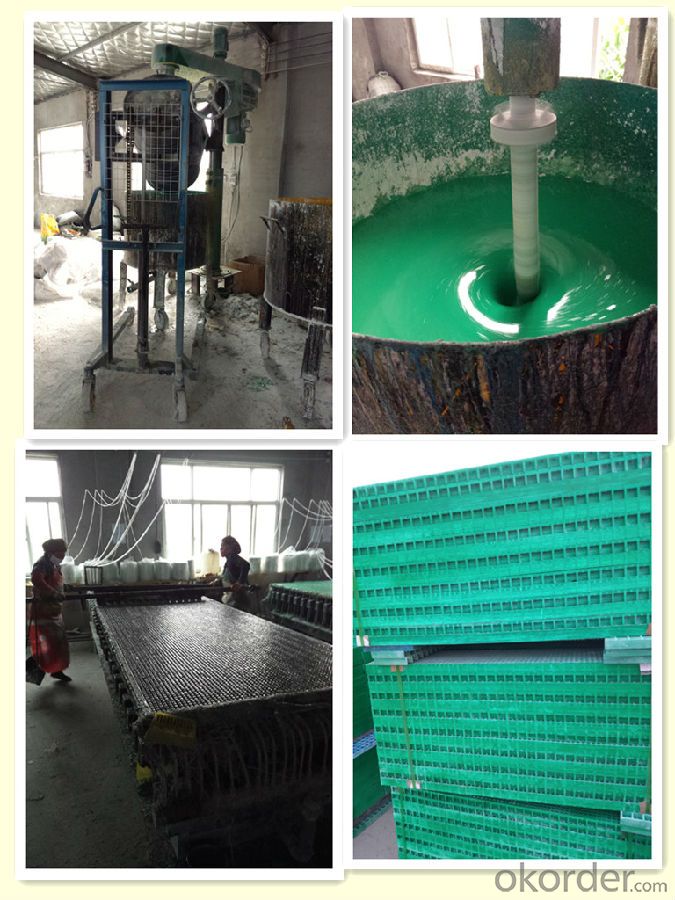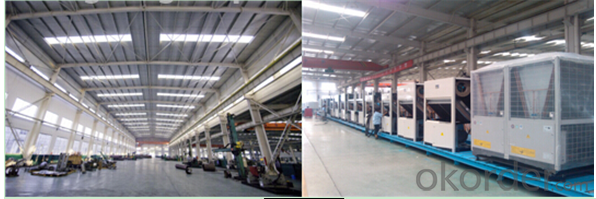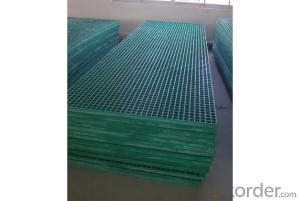Fiberglass Plastic Walkway Grating with all kinds of Color/Best Quality
- Loading Port:
- China main port
- Payment Terms:
- TT OR LC
- Min Order Qty:
- 100 m²
- Supply Capability:
- 500000 m²/month
OKorder Service Pledge
OKorder Financial Service
You Might Also Like
Introduction
FRP Molded Grating is a structural panel which uses high-strength E-Glass roving as reinforcing material, thermosetting resin as matrix and then casted and formed in a special metal mold. It provides properties of light weight, high strength, corrosion resistance, fire resistance and anti-skid. FRP Molded Grating is widely used in oil industry, power engineering, water & waste water treatment, ocean survey as working floor, stair tread, trench cover, etc. and is an ideal loading frame for corrosion circumstances.
Feature
l Corrosion Resistance
l Fire Resistance
l Light Weight & High Strength
l Safety & Anti-slip
l Electrical Insulating
l Aging Resistance
Specification

Advantage
1) coated with prevent aging layer
2) excellent insulating performance
3) no maintenance
4) high strength
5) long service life
6) easy installation
Application
l Power plants, substation equipment enclosures, antimagnetic, anti-static,to prevent small animals into the equipment failure, as there is electricity facilities and without power interval intervals.
l In high voltage electrical equipment for power line work, in order to prevent workers go wrong location, charged interval or near electrically charged equipment to dangerous distance.
l Pool railings in sewage treatment industry
l Corrosive chemical industry equipment around the fence
l All kinds of building maintenance section
FAQ
1. How about the documents after shipment?
After shipment, we ll send all original documents to you by DHL, including Packing List.Commercial Invoice, B/L, and other certificates as required by clients.
2. How long is the delivery time?
Usually it takes 10-25days after receipt of the deposits or L/C, and it also depends on the quantity of your order.
3. How's the payment?
Telegraphic Transfer(T/T) or Letter of Credit(L/C)
4. Do You Arrange Shipment?
Yes, dear esteemed customers, for FOB or CIF price, we will arrange shipment for you. For EXW price, clients need to arrange shipment by themselves or their agents.
5. How is the package?
Usually, we arrange the standard out-package for exporting.
PROCESS

FACTORY


- Q:What is the maximum length of FRP pultrusion profiles that can be manufactured?
- The length at which FRP pultrusion profiles can be manufactured is influenced by various factors, including the specific manufacturing process, equipment capacity, and transportation limitations. Generally, these profiles can range in length from a few feet to several hundred feet, but there are practical limitations that must be taken into account. Firstly, the size and capacity of the pultrusion equipment used in the manufacturing process often determine the length restrictions of the profiles. Different pultrusion machines have different capabilities, with length capacities varying from a few feet to over 100 feet. Manufacturers must consider the limitations of their available equipment when determining the maximum length they can produce. In addition, transportation and logistical constraints can also impact the maximum length of FRP pultrusion profiles. Longer profiles can be more difficult to transport due to restrictions on road transport, shipping containers, or handling capabilities. These limitations may vary depending on the region, infrastructure, and available transportation methods. It is worth noting that longer profiles may also face challenges in terms of quality control and dimensional stability during the manufacturing process. As the length increases, it becomes more challenging to maintain consistent mechanical properties and effectively control the curing process. Therefore, while there is no fixed maximum length for FRP pultrusion profiles, it is crucial for manufacturers to consider the technical capabilities of their equipment, transportation logistics, and quality control factors when determining the practical limit for the length of their products.
- Q:Are FRP pultrusion profiles resistant to fuels?
- Generally, FRP pultrusion profiles possess resistance to fuels. The combination of strong fibers and a polymer matrix grants FRP profiles significant resistance to a range of chemicals, including fuels. This resistance primarily stems from the non-reactive nature of the polymer matrix, which prevents fuel from causing notable degradation or harm to the profiles. Industries that frequently encounter fuel exposure, such as automotive, aerospace, and oil and gas sectors, commonly employ FRP pultrusion profiles. These profiles have undergone extensive testing and have demonstrated their ability to withstand prolonged contact with fuels without suffering detrimental effects. Furthermore, FRP profiles provide numerous advantages over traditional materials like steel or aluminum in applications involving fuels. They resist corrosion, are lightweight, and exhibit excellent dimensional stability, making them ideal for environments with a high risk of fuel exposure. However, it is important to note that the specific resistance of FRP pultrusion profiles to fuels may vary depending on the fuel type, concentration, and the composition of the FRP material itself. Therefore, it is always advisable to consult the manufacturer or supplier to ensure that the chosen FRP profiles are suitable for the particular fuel-related application.
- Q:Can FRP pultrusion profiles be used in wastewater treatment facilities?
- Indeed, FRP pultrusion profiles have the capability to be utilized in wastewater treatment facilities. These profiles possess numerous benefits, including a high strength-to-weight ratio, resistance to corrosion, and durability, all of which make them highly suitable for the challenging conditions found in such facilities. In wastewater treatment facilities, there exists a wide range of applications where FRP pultrusion profiles can be effectively employed. These applications encompass walkways, handrails, ladders, grating, and structural supports, among others. The corrosion resistance of FRP makes it particularly well-suited for deployment in areas that are exposed to moisture and the chemicals present in wastewater. Furthermore, the lightweight nature of FRP profiles simplifies the installation process and reduces the burden placed on supporting structures. The durability of FRP pultrusion profiles guarantees long-term performance, even in aggressive environments. They exhibit a remarkable resistance to chemical attacks, UV radiation, and bacterial growth, rendering them highly appropriate for wastewater treatment applications. Additionally, FRP profiles can be tailored to meet specific load requirements and can be easily fabricated to accommodate various shapes and sizes. Furthermore, FRP pultrusion profiles possess outstanding electrical insulation properties, which can prove advantageous in wastewater treatment facilities where electrical safety is of utmost concern. To summarize, FRP pultrusion profiles can be effectively employed in wastewater treatment facilities due to their corrosion resistance, durability, lightweight nature, and versatility in terms of design and fabrication. These profiles provide long-lasting solutions for a variety of applications within these facilities, ensuring operational efficiency and minimizing maintenance needs.
- Q:Are FRP pultrusion profiles resistant to oil or fuel spills?
- Yes, FRP pultrusion profiles have inherent resistance to oil and fuel spills. The combination of the fiberglass reinforcement and the resin matrix used in their construction make them highly resistant to the corrosive effects of oil and fuel, making them a suitable choice for applications where exposure to such spills is expected.
- Q:Are FRP pultrusion profiles resistant to moisture absorption?
- Yes, FRP pultrusion profiles are highly resistant to moisture absorption. The inherent properties of the fiberglass and resin used in pultrusion manufacturing make the profiles highly durable and impervious to moisture, ensuring long-term performance and minimal structural damage.
- Q:What is the impact resistance of FRP pultrusion profiles?
- The impact resistance of FRP pultrusion profiles is generally high due to the inherent strength and durability of the fiberglass reinforcement. The specific impact resistance may vary depending on factors such as the resin type, fiber orientation, and manufacturing process. However, FRP pultrusion profiles are known to exhibit excellent resistance to impacts and can withstand heavy loads and external forces without experiencing significant damage or deformation.
- Q:Can FRP pultrusion profiles be used in the construction of safety barriers?
- Yes, FRP (Fiber Reinforced Polymer) pultrusion profiles can be effectively used in the construction of safety barriers. FRP pultrusion profiles offer several advantages over traditional materials like steel or concrete when it comes to safety barrier applications. Firstly, FRP pultrusion profiles are incredibly strong and durable. They have high tensile strength, which means they can withstand heavy loads and impacts without deforming or breaking. This makes them suitable for withstanding the forces that safety barriers may encounter, such as vehicular collisions or other accidents. Secondly, FRP pultrusion profiles are lightweight. Compared to steel or concrete, FRP is significantly lighter, making it easier to transport, install, and handle during construction. The lightweight nature of FRP also reduces the overall weight of the safety barrier structure, which can be an advantage in terms of ease of installation and cost-effectiveness. Additionally, FRP pultrusion profiles have excellent corrosion resistance. Unlike steel, FRP is not susceptible to rust or corrosion, which can compromise the integrity and safety of the barrier over time. This makes FRP an ideal material for safety barriers that are exposed to outdoor environments or harsh weather conditions. Furthermore, FRP pultrusion profiles are non-conductive and non-magnetic, which can be advantageous in certain safety barrier applications. For example, in areas where electrical or magnetic interference is a concern, such as near power lines or sensitive equipment, FRP barriers can provide an extra layer of safety by avoiding any potential electrical or magnetic hazards. Overall, FRP pultrusion profiles offer a reliable and efficient solution for constructing safety barriers. Their strength, durability, lightweight nature, corrosion resistance, and non-conductive properties make them a suitable choice for a wide range of safety barrier applications.
- Q:Can FRP pultrusion profiles be used in the aerospace industry?
- FRP pultrusion profiles are suitable for use in the aerospace industry. They possess several advantages that make them ideal for aerospace applications. Firstly, their high strength-to-weight ratios are crucial in the aerospace industry, where weight reduction is a top priority. This lightweight quality contributes to fuel efficiency and increased payload capacity. Secondly, FRP profiles have excellent corrosion resistance, making them perfect for aerospace applications that involve exposure to harsh environments like high altitude, extreme temperatures, and moisture. This resistance ensures the durability and longevity of the components, reducing maintenance and replacement costs. Additionally, FRP materials can be customized to meet specific design requirements, allowing engineers to easily create complex shapes and structures. This flexibility in design leads to enhanced performance and functionality in aerospace applications. Moreover, FRP pultrusion profiles exhibit exceptional fatigue resistance, enabling them to withstand the cyclic loading and stress cycles commonly encountered in aerospace operations. This characteristic ensures the reliability and safety of the components, which is paramount in the aerospace industry. Furthermore, FRP materials offer electrical insulation properties, which can be advantageous in aerospace applications where controlling or minimizing electrical conductivity is necessary. This insulation capability contributes to the overall safety and functionality of the components. In conclusion, FRP pultrusion profiles are a viable and attractive choice for various aerospace applications, including aircraft structures, interior components, radomes, and others. Their high strength-to-weight ratios, corrosion resistance, flexibility in design, fatigue resistance, and electrical insulation properties make them a suitable option for the aerospace industry.
- Q:What are the typical load-bearing capacities of FRP pultrusion profiles?
- The typical load-bearing capacities of FRP (Fiber Reinforced Polymer) pultrusion profiles vary depending on various factors such as the specific design and configuration of the profile, the type and quality of the fibers used, and the manufacturing process employed. However, generally speaking, FRP pultrusion profiles have high strength-to-weight ratios and can offer significant load-bearing capacities. The load-bearing capacities can range from a few hundred pounds to several thousand pounds, depending on the size and cross-sectional shape of the profile. For example, smaller FRP pultrusion profiles with rectangular or square cross-sections may have load-bearing capacities in the range of 500 to 2,000 pounds, while larger profiles with more complex shapes, such as I-beams or channels, can have load-bearing capacities exceeding 5,000 pounds or more. It is important to note that the load-bearing capacities of FRP pultrusion profiles can also be influenced by factors such as the temperature and environmental conditions in which they are used, as well as any additional reinforcement or support structures that may be employed. Therefore, it is crucial to consult with manufacturers or engineers who specialize in FRP pultrusion to obtain accurate and specific load-bearing capacity information for a particular application.
- Q:Are FRP pultrusion profiles resistant to high winds or hurricanes?
- FRP pultrusion profiles offer exceptional resistance against high winds and hurricanes. Combining the robustness of fiberglass with the longevity of polymers, FRP is a lightweight yet remarkably sturdy material that can endure severe weather conditions. Extensive testing has proven that FRP pultrusion profiles exhibit outstanding wind resistance properties. They possess a remarkable stiffness-to-weight ratio, enabling them to withstand the powerful forces generated by high winds without deformation or breakage. Additionally, the inherent flexibility of FRP permits it to absorb and distribute wind forces, minimizing the risk of damage. In the face of hurricanes, FRP pultrusion profiles have demonstrated their capability to withstand the intense winds and airborne debris associated with such extreme weather events. They have been successfully employed in various applications, including building facades, bridges, and utility poles, in areas prone to hurricanes. Moreover, FRP pultrusion profiles possess corrosion resistance, providing an extra advantage in withstanding high winds and hurricanes. Unlike traditional materials like steel or wood, FRP profiles do not rust or decay when exposed to moisture, making them even more suitable for these demanding weather conditions. Overall, with their exceptional strength, durability, flexibility, and corrosion resistance, FRP pultrusion profiles are an excellent choice for applications requiring resistance against high winds or hurricanes.
1. Manufacturer Overview |
|
|---|---|
| Location | |
| Year Established | |
| Annual Output Value | |
| Main Markets | |
| Company Certifications | |
2. Manufacturer Certificates |
|
|---|---|
| a) Certification Name | |
| Range | |
| Reference | |
| Validity Period | |
3. Manufacturer Capability |
|
|---|---|
| a)Trade Capacity | |
| Nearest Port | |
| Export Percentage | |
| No.of Employees in Trade Department | |
| Language Spoken: | |
| b)Factory Information | |
| Factory Size: | |
| No. of Production Lines | |
| Contract Manufacturing | |
| Product Price Range | |
Send your message to us
Fiberglass Plastic Walkway Grating with all kinds of Color/Best Quality
- Loading Port:
- China main port
- Payment Terms:
- TT OR LC
- Min Order Qty:
- 100 m²
- Supply Capability:
- 500000 m²/month
OKorder Service Pledge
OKorder Financial Service
Similar products
New products
Hot products
Hot Searches
Related keywords





























